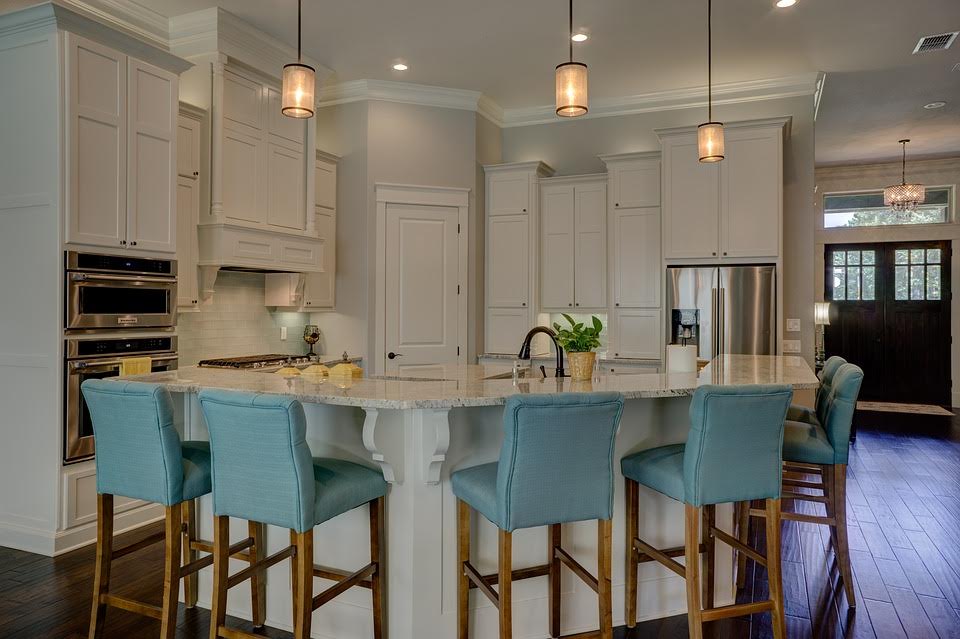Ready to Give Your Kitchen Cabinets a Fresh Look?
At Harbor Stone, we understand that your kitchen is a hub of your home – a place where you prepare and enjoy your coffee and food, hang out with your loved ones, and more. So it’s only natural that you want this focal space of your home to be efficient and visually pleasing.
We also know that many homeowners have to deal with a tired, worn, outdated kitchen. And, for many, major home improvements and remodeling is not possible right now.
The good news is – even just a fresh coat of paint for your kitchen cabinets can give your kitchen a fresher look and make it much more appealing!
If you love DIY projects, or you’re on a strict budget, here’s a tutorial on how to paint/resurface your kitchen cabinets:
Preparation
It all starts with a careful preparation. Taking into consideration the style of your kitchen, and the rest of your home, play with different looks and colors for your kitchen cabinets, so that they can nicely compliment countertops, walls, and flooring.
Next, take a look at the material your cabinets are made of, as that will determine the ease (or not) of repainting them. Wood, wood-laminate, or metal cabinets can usually be repainted without problems; if, however, they’re plastic laminates, it tends to be more difficult to paint over them, often requiring special paints and techniques. Also, keep in mind that if your wood cabinets have raised panels, routed profiles or other architectural detailing, you’ll need more time to prep and paint them.
Once you’ve chosen the paint/stain color, decide on the method for applying, depending on the amount of woodwork you wish to paint and the type of paint or finish. You can choose spraying, rolling or brushing, with a natural or synthetic bristle brush, or a foam brush.
Tip: if the cabinet wood is warped or damaged, consider getting new unfinished doors and drawers and painting them together with your existing cabinets.
Removing Doors and Hardware
Remove all doors, drawers, and hardware. It’s a good idea to place hardware and screws in plastic bags and store them inside the cabinets they were taken from, so everything goes where it belongs.
If your kitchen has a complicated layout, mark or number what came from where to make it easier to put back. If you’re painting only the drawer fronts, no need to remove the slides, but mark them and their locations if you need to remove them.
Cleaning Surfaces
All of the surfaces you want to repaint need to be cleaned to remove any grease, since steam and food splatters typically make kitchen cabinets quite dirty. You can use a solution made from one part tri-sodium phosphate and four parts water, rinse and allow to dry completely before proceeding to the next step.
Sanding
Sand the cabinet doors on all sides and faces, using a medium grit wood-sanding block. If you’re painting inside the cabinet boxes, make sure you sand inside, too.
If the old paint is in good condition, you don’t need to remove all of the paint; simply sand the surface to ensure the new paint has a smooth, clean base to adhere better. Pay attention to the worn areas of old finish and sand them well, as well as the shiny areas to deglaze all existing finish.
Next, vacuum all the sanding dust from all surfaces to blow the dust out of crevices or molding details. Finally, wipe away the dust from the areas to be painted with a tack cloth or damp lint free cloth.
Priming
Apply an even coat of primer-sealer to all surfaces, using water-based one for an even, durable finish. It’s best to let the primer cure for a full 24 hours; if need to, prime the backside of the cabinets the following day.
Painting
Start with painting the inside edges and openings of cabinets’ face frames; next move to the outer sides, and do the face frame fronts last.
Paint the cabinet doors and drawer fronts next; make sure to cover all raised or routed features, crevices and corners, and that paint does not accumulate in these spots.
Apply paint with thin, light coats – the brushstrokes will dry more quickly and be less visible. Tip: finish should not be applied too densely, and too many brush strokes may create air bubbles, resulting in bumps and pits.
You’ll likely need only two coats of quality paint; the third coat may be needed in kitchens where a lot of cooking happens. Make sure to wait at least four hours for the paint to dry before applying the next coat, re-sand the surface lightly, wipe away the dust with a tack cloth, and then paint another coat.

We hope you find this quick guide to DIY kitchen cabinet painting useful!
If you don’t have the time, expertise, or don’t want to invest your efforts into it – you can always count on our skilled and experienced kitchen remodelers to paint your cabinets, or install new ones.
As a locally owned company providing Quality General Contracting Services, at Harbor Stone we have a reputation for completing projects that meet or exceed expectations, on time and on budget.
Rely on Harbor Stone Construction Company’s expert knowledge and skills to customize and transform your space – whether you’re considering a total or partial renovation to transform your home into your dream home, or you’re looking to increase the value of your property in Chester County PA and Greater Philadelphia.
Contact us today to discuss your future residential and commercial projects.
